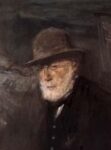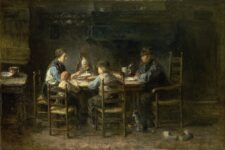
Jozef Israëls
Dutch, 1824-1911
Woman in Landscape, n.d.
oil on canvas
18 5/8 x 31 3/8 in.
SBMA, Gift of Sanford and Mary Jane Bloom
1992.54

Jozef Israëls - Self-Portrait (detail), 1908, watercolor on paper, Toledo Museum of Art, Ohio
“But again — speaking of technique — there’s a great deal sounder and more solid technique in Israëls — for instance in that very old work, the Zandvoort fisherman, with superb chiaroscuro — than the technique of those who are equally smooth and flat all over, and distinguished by their cold, tinny color.” – Letter to Theo, 13 October 1885
RESEARCH PAPER
In "Woman in Landscape" Josef Israels created a dark and moody landscape. A silhouette of a woman, bent with a heavy burden, is fading into the darkness while the last rays of the setting sun leave an orange glow that adds softness and gentleness to the painting. The landscape in the painting is bare, and one has the feeling that it is late fall or early winter. The woman is depicted in general brush strokes, and the outline of her figure is depicted in soft and blurry lines; in fact, the whole composition is not in focus. This use of blurry images conveys a feeling of movement or a glimpse into a moment of one’s life as we watch the woman pass by, to quietly disappear into the darkness.
By looking into the life of Josef Israels, one gains a better understanding about what shaped his career as a painter, and why he chose to paint this type of subject matter, such as "Woman in Landscape". Josef Israels was born into a poor Jewish family in the city of Groningen in Holland. His father was a small-time trader, a liberal who loved to read. Young Israels inherited from his father a love for books and poetry, while his mother was the main force behind his religious upbringing. From early childhood Israels was influenced greatly by the Bible, the Hebrew language, and the Jewish philosophy and way of life. Family, close knit Jewish community, and the Bible were the three circles with which he was surrounded, and within these circles he remained for the rest of his life.
Groningen, the city in which he was born, was a rich center and main market for grain, oil seeds, and tobacco. All around the city limits lay vast and rich cornfields and moorland. As a young boy, Israels was exposed to city dwellings as well as to the country landscape. But the cheerless moorland, combined with his understanding and sympathy for the poor and working class, left a strong and everlasting impression on him. The depiction of people struggling with their daily activities and the love he felt for them can be seen in his painting throughout his whole career.
At the age of 16 Israels went to Amsterdam to learn the Dutch Masters’ style of painting. After a long period of study, he recognized that the essentials in painting did not depend upon the painful methods of learning, but rather, on the correct assessment of the value of light and color and the free depiction of configuration and motion of persons and objects. (Eisler, 7) This personal observation reflects much about his natural bent or inclination which later became more aligned and greatly influenced by the Barbizon School. In 1845 he went to Paris to study the historical, romantic paintings which were so popular in the French salons at that time. "For more than a decade his talent was absorbed by historical and biblical paintings. Although the two styles of romantic and classical painting became an integral element in his subject matter, he remained faithful to his natural love toward naturalistic depiction of landscape, genre painting of peasant life, bold use of paint, and interest in atmospheric light effects.
In 1847 he returned to Holland for good. He no longer chose to paint the historical and mythological themes. Rather he established his love for depicting the working poor in rural landscapes, and the sympathy he felt for the working class, which can be seen in his genre paintings as his brush captured the patient acceptance of life’s hardships. His genre paintings of domestic scenes are not meant to be seen as gloomy, dark or lonely; rather, as a gentle and quiet celebration of human spirit as people engaged in their simple, daily activities. Mirth and melancholy meet in. peace in his paintings as one blends into the other.
By mid-19th century he became involved in the formation of the Hague School, which was centered in Hague. The Hague group was greatly influenced by the Barbizon School and by the Dutch Masters, and their interests lay in their local landscape, while mastering the art of depicting atmospheric light effects and luminous atmosphere. Josef Israels, unlike the rest of the group, was not a landscape artist, but a peasant painter, and he placed between their celebration of color and light a touch of sadness. He became to be known as "the heart of the school", and became the troop’s best-known member. At that time his world view philosophy was centered in man, as a lonely human being, and his use of light was not only a way to achieve artistic effect, but a tool to reveal the existence of soul and humanity within a figure. His ideal was "to paint a woman weeping bitterly Without visible tears". (Eisler, 22)
The period of Israels’ mature work lasted almost 50 years, as he covered broad aspects of the local rhythm of life around him. Scenes of peasants, fishermen, Jewish life, quiet family scenes, isolated dunes and foaming seacoasts were all subjects he felt great love for and connection with. Most subject matters described a moment in one’s life, and most painting depicted a quiet moment as all colors and light resolved themselves into dim tones. His depiction of human and nature alike were not done with clear, clean lines, but rather, with suggestive, loose paint brush. Israels embraced not just the figure, but the figure’s whole surroundings in which air and light were blending in a richness of tones to fade away into the background.
Prepared for the Santa Barbara Museum of Art Docent Council by Niki Bruckner, March 24, 1996
BIBLIOGRAPHY
Max Eisler, Josef Israels, Holme, London, 1924
The Random House Dictionary of Art and Artists, David Piper Ed., Random House, Inc., New York, 1984

Israëls - Peasant Family at Table, 1882
COMMENTS
Van Gogh's Potato Eaters dates back to 1885 when representations of unidealized rural life were not common and certainly not welcomed by critics. A quick perusal over the most glorified representations of the time shows another story - instead of overlabored, emaciated, crumpled in a poor-lit room, sharing-a-meager-meal peasants - the leading painters such as Jean-François Millet glorified the peasant life, with sun-filled fields, athletic figures doing work with ease, and abundance.
Struggling for recognition and barely surviving, van Gogh turned instead to Jozef Israëls and Charles de Groux for inspiration. Both painters explored less appealing aspects of rural life, showing struggles, poverty, and woes of disadvantaged people and peasants with great empathy.
https://www.widewalls.ch/magazine/the-potato-eaters
Jozef Israëls, (born January 27, 1824, Groningen, Netherlands—died August 12, 1911, The Hague), painter and etcher, often called the “Dutch Millet” (a reference to Jean-Franƈois Millet). Israëls was the leader of the Hague school of peasant genre painting, which flourished in the Netherlands between 1860 and 1900. He began his studies in Amsterdam and from 1845 to 1847 worked in Paris under the academic painters Horace Vernet and Paul Delaroche.
Israëls first tried to establish himself as a painter of Romantic portraits and conventional historical pictures but had achieved little success when in 1855 ill health compelled him to leave Amsterdam for the fishing village of Zandvoort, near Haarlem. That change of scenery revolutionized his art: he turned to realistic and compassionate portrayals of the Dutch peasantry and fisherfolk (e.g., Waiting for the Herring Boats, 1875). In 1871 he moved to The Hague, and he often worked in nearby Scheveningen.
Besides oils, Israëls worked in watercolors and was an etcher of the first rank. His later works in all media express a tragic sense of life and are generally treated in broad masses of light and shade. His painting style was influenced by Rembrandt’s later works, and, like Rembrandt, Israëls often painted the poor Jews of the Dutch ghettos (e.g., A Son of the Chosen People, 1889).
https://www.britannica.com/biography/Jozef-Israels
SBMA CURATORIAL LABELS
Along with Van Gogh’s cousin, the artist Anton Mauve, Jozef Israëls was considered one of the leading artists of the Hague school, and one whom Van Gogh deeply admired. Although trained as a history painter in Amsterdam, as well as in Paris by leading academicians, Israëls consciously chose to devote himself to depictions of the poor. Often compared to the French artist Jean-François Millet for his empathetic depictions of laborers, Israëls’ art often has a piteous aspect, with an impending sense of futility or doom. He was also compared to his countryman, the 17th-century Dutch master Rembrandt, for his dramatic use of shadow.
In this painting, the stooped outline of a lone peasant woman, trudging home at the close of day, conveys the weariness of her daily life. We cannot know the effect that the melancholy beauty of the last vestiges of sunset has on this exhausted soul, whose eyes remain fixed on the path before her. As Van Gogh put it: “This is far from all theology ‒ simply the fact that the poorest woodcutter, heath farmer or miner can have moments of emotion and mood that give him a sense of an eternal home that he is close to.”
- Through Vincent's Eyes, 2022
